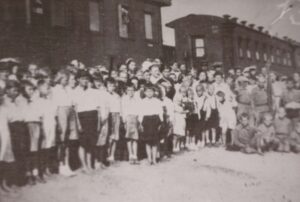Nadezhda Kubik
On 28 September 1939, the Soviet Union and Germany signed the Boundary and Friendship Treaty, according to which the territory of Poland was divided between the two countries. The inhabitants of the regions annexed to the USSR – which became part of it as the western regions of Soviet Belarus, Ukraine and partly Lithuania – were described by the Soviet regime as a “socially dangerous element” and deported deep into the empire in several waves. For these people, this meant a tragedy that lasted for many years. From the beginning of 1940 to the end of June 1941, over 300,000 people were deported to Siberia and Kazakhstan in four so-called mass deportations. For several years, Pavlodar Region became home to over 11,000 Polish citizens.

Departure of Polisch children from Kazakhstan in 1946. Source: The collection of the State Archive of Pavlodar Region in Pavlodar
Halina Gurska (Górska?), deported on 13th April 1940 from the town of Szczuczyn in the Białystok region, recalled that the train reached Pavlodar station on 29th April. Thousands of Poles were dropped off right on the banks of the Irtysh River. They spent three days on the bare ground in a piercing wind, and it was not until 3rd May that they were dispatched to various regions. Eight-year-old Halina, with her parents and seven siblings, were brought to the Akkul’skiy sovkhoz in the Kuybyshev region, where they survived six long years in difficult conditions. During this time, the family was reduced by half.
Nadezhda Kubik is a vice-director of the State Archive of Pavlodar Region in Pavlodar (Kazakhstan)
Read the text in Polish here: https://swiatsybiru.pl/pl/nie-wszyscy-wrocili-do-domu/



